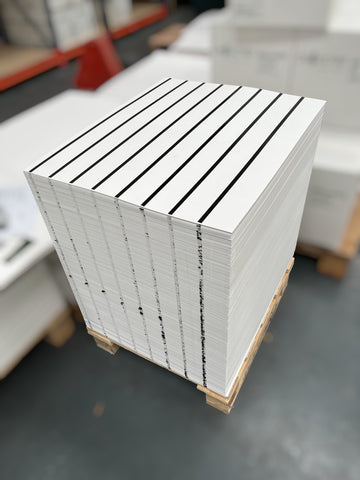Magnetic Tape Laying
The Magnetic Tape Application Process in Gift Card Production

Gift cards have become a ubiquitous part of modern consumer culture. They offer convenience, flexibility, and personalisation, making them a popular choice for gift-giving and promotional purposes. One essential element in the production of gift cards is the incorporation of magnetic tape, often used for storing and encoding information. Below we delve into the process of laying magnetic tape onto sheets of gift cards, exploring the intricate steps involved in ensuring these cards are functional and aesthetically appealing.
Introduction to Gift Card Production:
Before delving into the process of applying magnetic tape, it's crucial to understand the broader context of gift card production. Gift cards are typically made of PVC plastic or similar materials due to their durability and flexibility. These cards are manufactured in large sheets, which are later cut into individual cards. Incorporating magnetic tape into these sheets is a pivotal step that enables the cards to store data, such as account balances, access codes, or gift values.
Materials and Equipment:
PVC Sheets: Gift cards are usually made from PVC sheets, which provide the necessary rigidity and durability.
Magnetic Tape: Magnetic tape, also known as magnetic stripe, is a thin, flexible strip coated with magnetic particles. It is available in different coercivity levels (high-coercivity and low-coercivity) to suit various applications.
Card Production Equipment: This includes card printers, laminators, magnetic tape applicators and cutting machines. Card printers are used to print the card design and encode the magnetic stripe, while laminators apply a protective layer over the card surface.
Adhesive: A special adhesive is required to secure the magnetic tape onto the PVC sheets.
The Magnetic Tape Application Process:
The process of applying magnetic tape to sheets of gift cards can be broken down into several key steps:
Design and Data Encoding:
The process begins with the design of the gift card, which may include branding elements, artwork and space for the magnetic stripe. The magnetic stripe can be located on the back of the card, typically in a horizontal or vertical orientation. The stripe is divided into three tracks, with Track 1 and Track 2 being the most commonly used for encoding data. These tracks can store information such as card numbers, expiration dates, and security codes.
Once the card design is finalised, data encoding takes place. This involves programming the magnetic stripe with the necessary information using specialised encoding equipment. Data is often encoded in a format compatible with point-of-sale (POS) systems, allowing the card to be used for transactions.
Printing the Card:
After data encoding, the card design is printed onto the PVC sheets. Card printers use a variety of printing technologies, including dye-sublimation and thermal transfer, to produce high-quality, full-color images and text on the cards. The printer also has the capability to print variable data, such as unique card numbers, barcodes and QR codes which may be linked to the magnetic stripe data.
Lamination:
To protect the printed design and ensure card longevity, a lamination process is employed. Laminators apply a clear, thin layer of protective material over the card's surface. This layer not only enhances the card's durability but also provides an ideal surface for adhering the magnetic tape.
Preparing the Magnetic Tape:
Before the magnetic tape can be applied to the cards, it must be prepared. This involves cutting the magnetic tape into strips of the appropriate length and width. The width of the tape corresponds to the width of the magnetic stripe on the card.
Applying the Adhesive:
Adhesive is applied to the back of the prepared magnetic tape strips. This adhesive is specially formulated to ensure a strong bond between the tape and the PVC surface of the gift card. The adhesive is evenly distributed to avoid lumps or irregularities that could affect the card's appearance and functionality.
Magnetic Tape Application:
The heart of the process is the application of the magnetic tape onto the laminated PVC sheets. This step requires precision and accuracy to ensure that the tape aligns perfectly with the designated area on the card. Specialised magnetic tape applicators are used for this purpose. These machines use a combination of rollers and pressure to securely attach the tape to the card's surface.
The alignment of the tape is critical, as even a slight misalignment can result in reading errors when the card is swiped through card readers. Therefore, the applicator is equipped with mechanisms for fine-tuning the tape's placement.
Quality Control and Testing:
Quality control checks are essential to ensure that the magnetic tape has been applied correctly. Samples of cards from the production run are subjected to thorough testing, including swiping them through card readers to verify that the encoded data is read accurately.
Cutting and Finishing:
Once the magnetic tape is applied, the large PVC sheets are cut into individual gift cards using cutting machines. These machines use precise measurements to ensure each card is the correct size. The cards may also undergo additional finishing processes, such as rounding the corners or adding signature panels, as per the design specifications.
Packaging and Distribution:
The final step involves packaging the gift cards for distribution. They may be bundled in sets, attached to packaging materials, or individually sealed in protective sleeves or blister packs. The packaging is often designed to enhance the presentation of the gift cards, making them attractive and suitable for retail displays.
In conclusion, the process of laying magnetic tape onto sheets of gift cards is a meticulous and multi-step procedure that combines design, data encoding, printing, and precise application. The incorporation of magnetic tape enables gift cards to store and retrieve essential information, making them a versatile tool for various purposes, from gift-giving to loyalty programs and secure access control. The attention to detail and quality control throughout the process ensures that the final product is both functional and aesthetically pleasing, meeting the demands of a growing gift card market.
